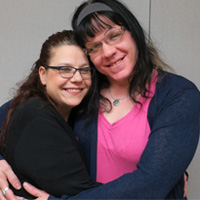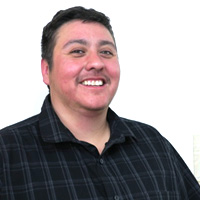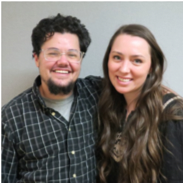Finding her truth and her calling
Jean Bryant helps others after discovering peace, and complexity, in her own transition

Jean Bryant seemed to have it all: A long career in the U.S. Forest Service as a tree cultivator, firefighter and more. A wife and two sons. A small town’s respect as a scoutmaster, volunteer firefighter and exalted ruler of the Elks Lodge. A national post as vice president of a federal employees’ union.
But as long as people saw Bryant as a man, she didn’t have what mattered most:
Herself.
Bryant knew her true gender before she was in kindergarten but cloaked herself in a man’s life. “It was not safe for me, so I invested very heavily in living the kind of life that would allow me to survive,” she says, her eyes glinting.
Transitioning, especially as a pillar of her Northwest community, seemed out of the question. “I thought I would end up living under a bridge, that I wouldn’t have anyone.”
Soon enough, events would force the issue. Bryant would learn how challenging and rewarding becoming herself would be.
“My world came crashing down”
For most of her life, Bryant cross-dressed in secret. After she retired from the Forest Service in 2012, she had more time alone. Her wife still worked as a nurse traveling to small school districts in eastern Washington. “I found myself spending more and more time honoring my female persona and growing more comfortable with that,” Bryant says.
One day, Bryant’s wife asked Bryant to load things in her car for an overnight trip. Propped on the back seat, “almost like you’d leave a note for somebody to make sure they saw it,” was a book on transgenderism.

“My world came crashing down,” Bryant says. “I thought, ‘She must know. It’s oozing out. I haven’t kept it secret enough. She’s sending me this signal.’”
Panicked, she sat at her kitchen table that night with a loaded revolver. She put it in her mouth and pulled back the hammer.
“At that moment, I sensed so strongly a voice that said, ‘You don’t want to do this. … It will be the wrong thing for your soul.’” She put the gun down.
When her wife returned the next morning, “I just said, ‘We have to talk,’” Bryant says. “I just spit it out.” Her wife listened, mouth open, for three hours. When Bryant finished, “she just looked at me and said, ‘Well, that explains a lot.’”
Their relationship had always been more platonic than romantic. “She realized at that moment why that full depth never manifested itself — I was a cardboard cutout of an image, a role I was trying to play.”
The book, it turned out, had nothing to do with Bryant. Her wife was reading it to help a teenager in one of her schools. But it ended up helping Bryant, too. Once the truth was out, “the sense of relief was huge.”
Family and friends stick with her
Bryant began transitioning with counseling and hormone therapy. After four or five months, she told her grown sons. “One was like, ‘Far out, what do you want me to call you now?’ ” she says. “The other one grilled me. It took him months to come around.”
Bryant’s wife stayed for two years but ended their 35-year marriage after Bryant decided to have surgery. They remain friends. They share an old pickup and help each other with yardwork and other chores. Bryant still attends gatherings with her ex-wife’s family. Her sons, who call her Jean, don’t live close but stay in touch.
“My family stayed intact,” she says, tearing up.

Friends stuck with her, too. Bryant lives in Vancouver but still visits her small town, “and nothing has ever happened.” When she tried to turn in her resignation to the president of the National Federation of Federal Employees, Bryant says, he tore it up and told her: “No, you don’t. We need you.”
“My transition happened in front of a 20,000-member union,” says Bryant, who finished her term in 2016. “But I had a lot of support. I feel so fortunate.”
Another milestone came when she was in transition and presenting as androgynous. She stepped into a fast-food place at the Albuquerque airport. The person behind the counter looked at her, smiled and called her “ma’am.”
“That was the first time I was ever ‘ma’am-ed,’ and it was a complete surprise. I blushed,” Bryant says. “What that says to me is that transition happens from the inside out, not the other way around. We communicate on levels that we rarely even think about.”
She also discovered that surgery is a step in the process, not the endpoint. Bryant had bottom surgery in 2016 with OHSU’s Dr. Daniel Dugi, an expert urologist who specializes in vaginoplasty.
“I’m very happy with it,” she says, but surgery is “a scalpel, not a magic wand.”
“I call it the Pinocchio syndrome — folks tend to think they’re going to wake up on the other side of these surgeries and everything’s going to be great. And it’s not,” she says. “It takes a long time to truly heal, and I don’t mean just physically. The transition continues.”
“I have to give back”
Bryant speaks directly and with a firm gaze, but she also smiles easily and sprinkles her conversation with self-deprecating humor. “Don’t let the Revlon fool you,” she says. “I’m 66 years old.”
She now uses her kind but plainspoken manner to help others in transition. “I feel like I’m called as a missionary,” she says. “I can’t believe how privileged I am — economically, socially, educationally. I have to give back.”

Bryant co-hosts a radio show on transgender issues. She also volunteers with OHSU’s Transgender Health Program, teaching classes and providing peer support. Through the Here4You program she helped design, she joins surgery patients at appointments and helps them find their way around OHSU. She also stays in touch by phone — sometimes for hours at a time — for months after their surgeries.
Amy Penkin, Transgender Health Program clinical program manager, says Bryant is an “incredibly compassionate person.” Bryant shares her experiences, Penkin says, but leaves room for patients “to have their own perspective and their own journey.”
Bryant’s journey continues, too. She doesn’t know where life as Jean Bryant will take her, but she’s eager to explore the possibilities. She still loves the outdoors — sailing, kayaking, hiking, fishing and, occasionally, golfing. “Now I get to legitimately hit from the ladies’ tees,” she says.
She’s also relieved that she’s no longer living a lie.
“Not a single one of the boogeymen I thought would come out from under the bed has manifested itself,” she says. “I almost hate to admit how — I wouldn’t say easy — how smooth transition has been for me.”
— By Pete Lesage, a Tigard writer and editor who previously worked as a reporter, editor and director at The Oregonian.
For patients
Request services
Please fill out an online form:
Other questions and concerns
Contact us at:
Refer a patient
- Please complete our Request for Transgender Health Services referral form and fax with relevant medical records to 503-346-6854.
- Learn more on our For Health Care Professionals page.
“Transpositive PDX”
What: A monthly radio show on transgender issues co-hosted by Jean Bryant
Where: KBOO, a nonprofit radio station airing at:
- 90.7 FM Portland
- 104.3 FM Corvallis
- 91.9 FM Hood River
When: 6-7 p.m. on the first Tuesday of the month
Previous episodes: KBOO’s website
StoryCorps
StoryCorps and OHSU are partners in bringing the stories of OHSU patients, providers and others to life. Here are two stories from International Transgender Day of Visibility 2018:

Molly Palmer and her wife, Melissa, reflect on Molly’s transition. They talk about how Molly told Melissa she was transgender, Melissa’s reaction and the strength of their relationship.

Tobin Cox, an OHSU employee and Transgender Health Program volunteer, joins clinical program manager Amy Penkin to talk about transitioning as a new employee.

Corey Gallet de St. Aurin, an OHSU medical student, talks with his roommate, Nicole Ovregaard, about deciding to transition, what he’s learned and what it’s like being transgender in Portland.